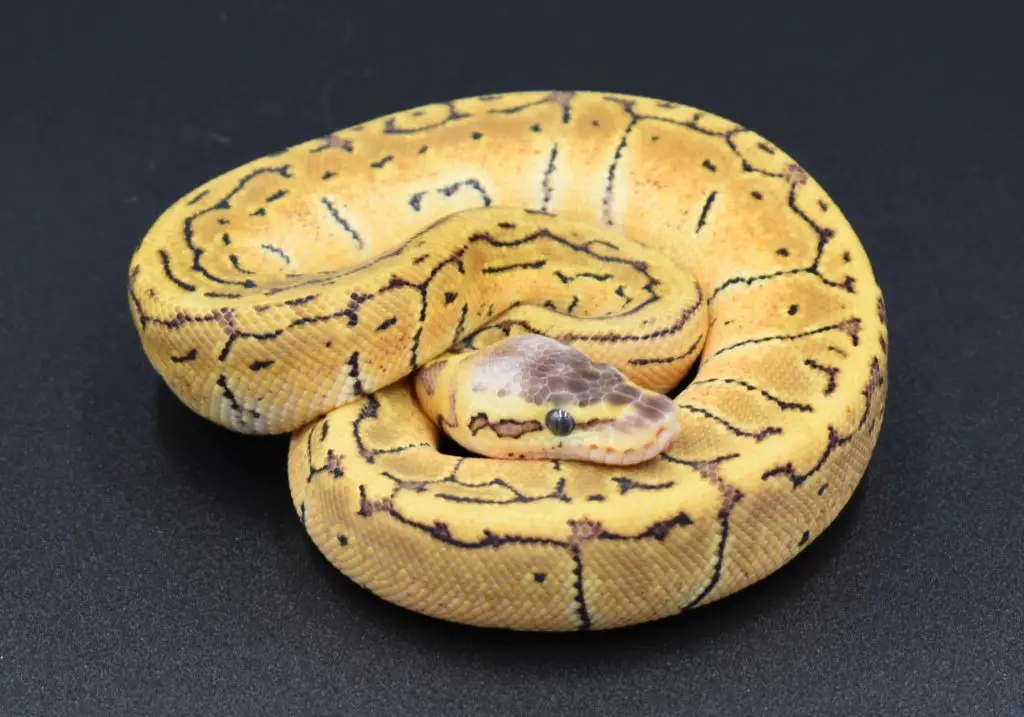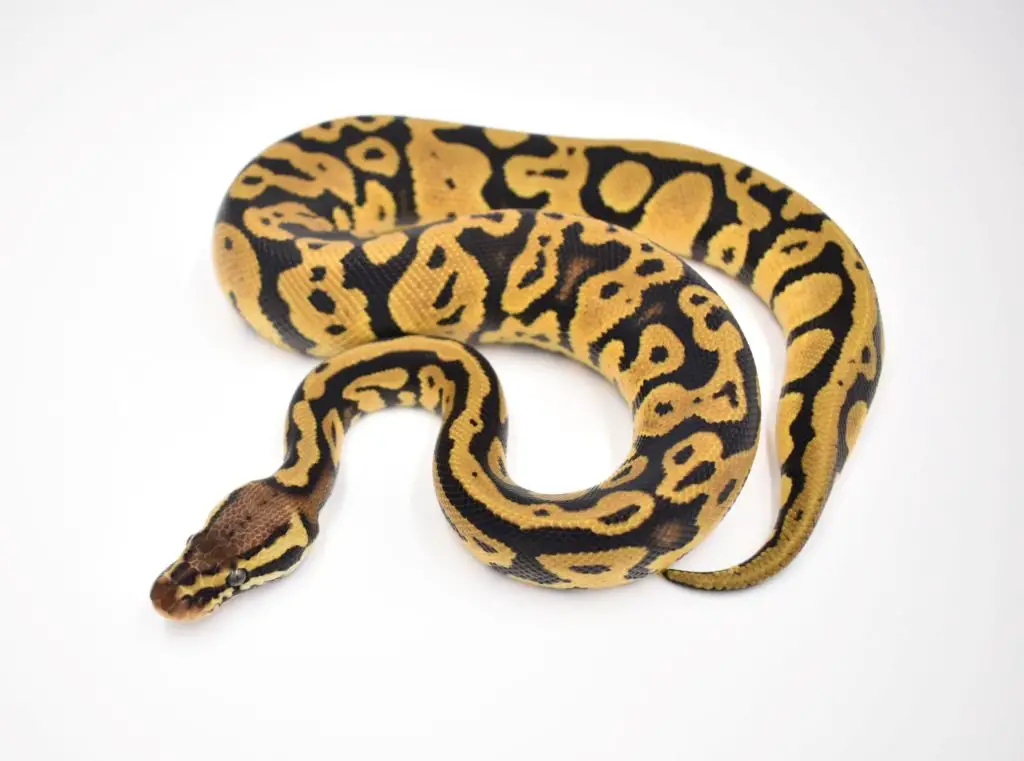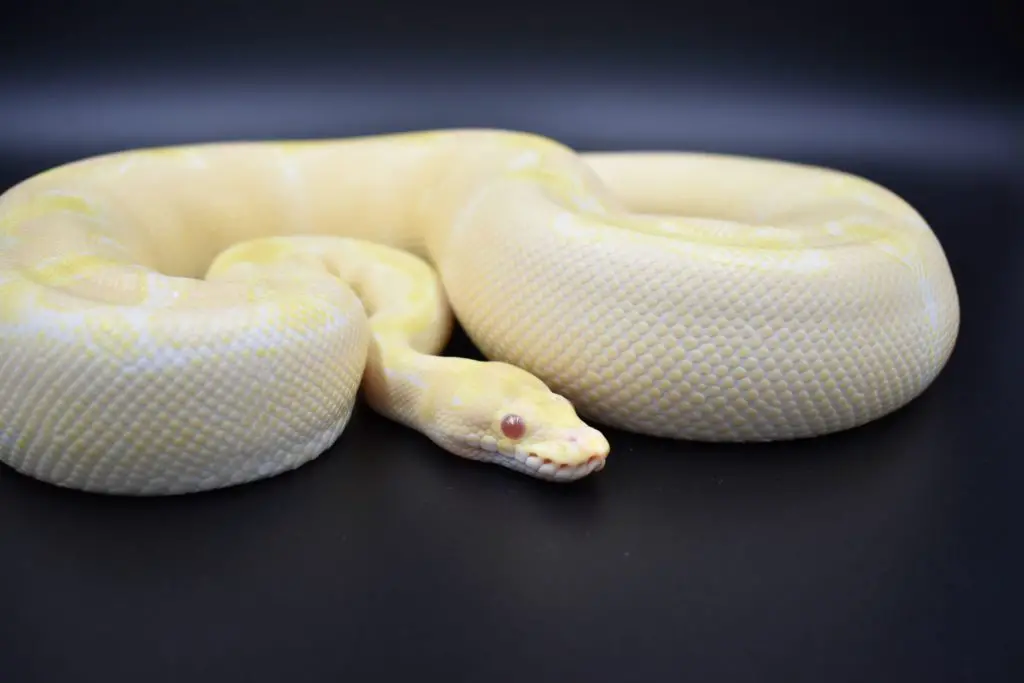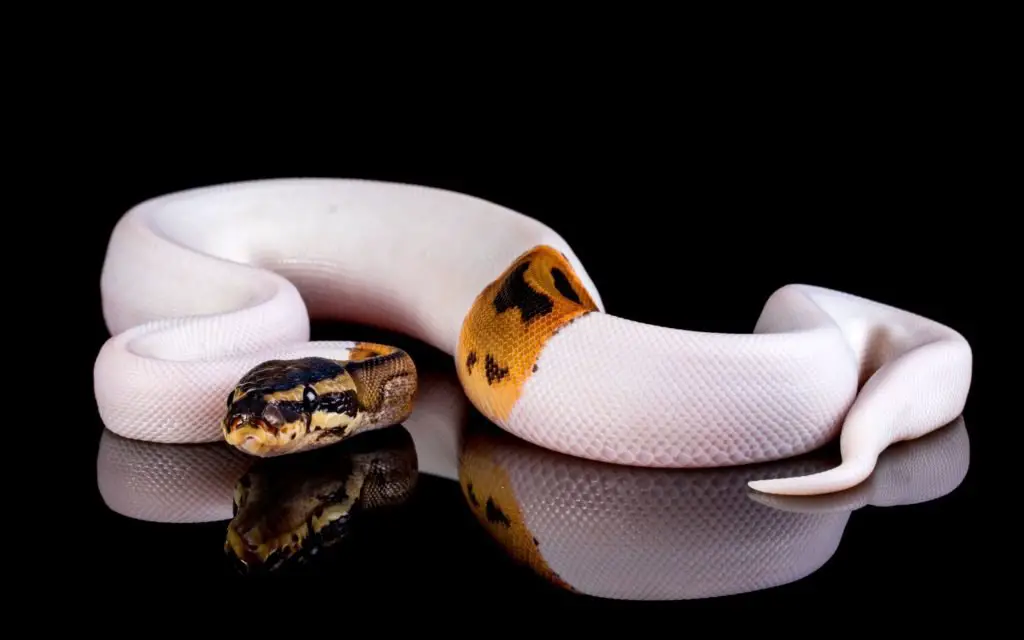You can breed Ball Pythons for a little profit fairly easily. But if you want to make a fully-fledged business out of breeding these snakes then you are in for a rough ride. Making a reptile business profitable is just as tough as any other business. It is a long-term project with inevitable setbacks. Nonetheless, the profit is high if you manage to get established.
In this article, I’ll take you through my thoughts and experience on breeding Ball Pythons. I got my first Ball Python 25 years ago and started breeding them over 10 years ago. That said, it’s always been a hobby, rather than a full time job. At the same, I have known people who’ve made it into a successful business and given me advice about going down that road. Spoiler alert: not one of them got up and running in less than 5 years! Oh, and not one of them told me it was easy!
Before we go into all that though, I’m going to go through the 6 main steps you’ll need to carry out when breeding your snakes. After that, I’m also going to give you some of my top tips for selling baby snakes.
The 6 main steps to breeding
Obviously breeding is a long process, but here we’re going to look at the six major steps that you’ll go through when breeding your snakes. This way you can get a feel of just how involved the process is…
1. Plan your projects
This is crucial: breed for morphs that are in-demand or that always sell. This could be the difference between quickly selling your hatchlings, or getting stuck with them (and the feeding and housing costs they entail).
Personally, I’ve made no secret of the fact that I often put Lemon Blasts into breeding projects. This is because Lemon Blasts are a pretty morph that always sells fast. They aren’t valuable, but selling a few quickly gets you some money back whatever might be happening with the market at that time.
Other morphs that sell quick include Orange Dream and Highway/Freeway combos. You can also go for more high-end recessive morphs like Piebald, but these are sometimes slightly harder to move on as a new breeder.
2. Get your snakes up to weight
Once you’ve chosen a couple of breeders (or more, obviously) you need to get them up to weight. If you bought them as hatchlings, feed them consistently until they reach maturity. This could take anywhere from 12-24 months for a male, or 24-36 months for a female.
If you buy adult or subadult snakes, plan for a 6 month feeding period before you start breeding them. I prefer my males to be at least 800grams and eating well. For females, I generally won’t pair them before they are at least 1400-1500 grams and feeding well.
3. Pair them once a month until they stop
If you’re snakes are up to weight, healthy, and feeding consistently, you can start pairing them in October or November. Pair them once a month, and keep a record.
Often, they’ll lock a total of around 4-6 times before stopping on their own. When to stop pairing Ball Pythons is a common question, but my advice is to keep pairing them until the female rejects the male twice in a row.
4. Watch for ovulation – then calculate a due date
A little while after the female starts rejecting the male she’ll stop eating, then get a bulge in her midsection called a build. This is the follicles getting ready for fertilization.
Eventually, fertilization will occur – known as ovulation. Your female will look like she’s swallowed a huge meal, and her belly will have a weird crease down the middle of the ventral scales.
It’s important to record the date of ovulation, as it let’s us predict when the eggs will be laid. Generally, my females shed within 12 days of ovulating, then lay their eggs around 30 days after that.
5. Incubate the eggs
Obviously, you should have an incubator set up and ready to go long before the eggs arrive. For more information on this, go to the “Eggs” section of the Ball Python Care Hub (follow the reproduciton page link at the bottom of this post).
Egg incubation usually takes around 60 days, and is by far the most frustratingly long part of this whole process! Eventually though, the babies pop out as if by magic.
6. Advertise the babies
Last but not least, the tricky little step of advertising the babies. There are lots of places you can sell them. My advice, though, is to just get an account on Morphmarket.com and sell them there. Everyone uses Morphmarket. If you keep reading, I have added a few of my top tips to help with the marketing process.

Is breeding Ball Pythons profitable?
If you’re like me – you’ll never make a huge profit breeding snakes. I’m an obsessive reptile keeper, and any time I make a little money from my Ball Pythons, I just buy more! If, on the other hand, you have a little self-control then you can make a profit from breeding this species.
When you invest in high-end morphs that are either gaining or at stable popularity, like Acid/Confusion, Puzzle, Desert Ghost, Tri Stripe, Cryptic, Pied and Clown, you can make excellent returns.
You can also make good returns selling pretty, but lower-end morphs that sell fast. The good old Lemon Blast morph, for example, always sells well.
The problem is you need the money to invest in the first place. If you want to make more than a few hundred bucks a year from this hobby, you should be prepared to invest at least $3 to 5k to start with.
To launch a breeding program as a full-scale business (no pun intended) you should be prepared to scale up the investment. Ideally, you should have a good $20 to 30K worth of breeders ready to produce clutches.
After all, the great Justin Kobylka of Kinova (one of the world’s leading Ball Python businesses) makes no secret of the fact that his initial investment was $75K!
As with any animal breeding project, the returns depend on how many animals you have, and sometimes how lucky you are.
The margins are high, but not guaranteed each year. No one can give you a 100% precise estimate of how much profit Ball Python breeding makes!
You could literally invest $5K and make back anywhere between $2 and $15K over the next 3, 5, or even 10 years.

How hard is it to make money breeding Ball Pythons?
As a new breeder, you should be aware of the fact that you are entering a mature market. The big breeders have been here for a long time, and there isn’t a lot of room for newcomers to wriggle their way in.
The fact of the matter is, when you first pop up on Morphmarket, or other sales sites, you have zero brand recognition. The market is already saturated, and you need to build that brand recognition over time to become truly successful.
That doesn’t mean you shouldn’t bother breeding though. You just need to remember that there are two ways around this problem.
If you do these things, you can compete with more popular sellers:
1. Make yourself useful to local buyers.
If you drive, I strongly suggest adding “free local delivery possible” to your ads.
This is about selling your snakes, and hopefully having a good time whilst doing it. Don’t get hung up over fuel costs.
Offer to deliver snakes to buyers within a twenty-mile radius and more often than not they will buy yours rather than spend extra on delivery from a breeder 100 miles away.
Think about it. What’s better – burning $5 or $10 on fuel, or losing $200 by not selling a snake?
2. Advertise with great photos
Photos are everything now. Nice photos sell snakes, and pretty much anything else. If your snakes are bright and healthy, advertise with photos that do them justice.
If you can, invest in a light tent to do photos of your hatchlings. I also recommend buying a good camera, or even borrowing the latest iPhone from a friend or family member to get some nice shots.
If your ads all have great photos of bright, colourful snakes, then they will sell.

Building brand recognition
Obviously, the tactics I mention above are valid for all sellers but particularly important for new breeders.
Eventually, though, you want the same brand recognition that the big breeders have. This is what I would call a “hidden cost.” Time is money, and you’ll need to spend a lot of time on this.
If you do decide to really make a go of breeding Ball Pythons, be prepared to invest huge amounts of time in building a social media following, and a Youtube channel.
Almost all of the most successful breeders around today have recognised the importance of brand recognition and have at least 25K subscribers on Youtube. This gives them an interactive market of loyal followers to sell to.
An added bonus to brand recognition via Youtube is that it eventually gives you another revenue stream. Get enough subscribers, and you can monetise a channel.

Having a background in marketing is better than a background in zoology
This is all starting to sound a little like classic sales advice, isn’t it? Well, to be honest, a degree in marketing would be a lot more useful for selling Ball Pythons than any of my qualifications.
That’s just how it is. You could be a herpetologist, but it wouldn’t help you sell your snakes. Being a smart investor and keen marketer is far more important.
Pay attention to what sells, and what doesn’t. Pay attention to what kind of ads and language work, and which don’t.
Do short, straight to the point descriptions sell more snakes? Or do longer, more detailed ads get more attention?
The answers to these questions often vary by region and country – so I can’t tell you. You must observe what’s going on with other breeders’ sales so that you can get a clear picture of what works and what doesn’t.
Say goodbye to your “pets”
Do you want to make money from breeding Ball Pythons? Then be prepared to sell snakes that are no longer valuable, or useful to your projects.
This means selling breeders that you’ve raised to adulthood and kept for as long as ten years. If you get attached to them, like most of us do, then selling them is more than a little sad.
It has to be done, though. Keeping snakes that are no longer useful for breeding takes up room and resources. If you do this, then you will not make as much profit from breeding your other Ball Pythons.

The most common setbacks
This species is easy to breed – when they feel like it. Sometimes they don’t though! I’ve had males that showed zero interest in the lovely females I’d lined up for them.
I’ve also had females that decide to skip a year, despite being in full health and the correct weight. It’s just something they do.
The setbacks don’t stop there either, just take a look at the list below of common issues breeders face:
- The wall – females that just stop eating at 1000g
- Females that skip a year
- Males that take an extra year to mature
- Males that just aren’t interested
- Incubator problems and lost clutches
- Failing to sell animals
- Deformed babies
- Issues with landlords
Most of these setbacks are minor for big breeders. What’s it matter if two males out of 200 are slow to mature?
For hobbyist breeders, however, setbacks with one of two animals can kill profits for a year. This is another time when investing more initially (in terms of more animals) is advantageous.

What are the pros and cons of breeding?
The process of breeding Ball Pythons is easy. They do a lot of the work after all! What isn’t easy is getting the time and money to devote to the project. If you do manage it, you may or may not enjoy it due to the following pros and cons involved:
| Pros | Cons |
| Hatching babies is an incredible experience! | Losing babies is a horrible experience! |
| The margins are high | Projects take a long time to mature |
| Brand recognition gets you new friends and contacts | Brand recognition is time consuming |
| You will be your own boss if you turn it into a business | The initial investment can be high |
| You’ll have an INSANE Ball Python collection! | You have to sell animals you’ve grown attached to |
The bottom line
You can make a lot of profit from breeding Ball Pythons. But only if you invest a lot of money! If you’re just a hobbyist breeder like myself, you probably will end up spending most of your profit on new snakes.
How much you can make varies depending on what morphs you invest in, how well you build your brand recognition (Youtube, FB, forums, etc.) and to a certain extent, how lucky you are. Research is the key to success, and stickability. There will be setbacks, and you’re entering a saturated market!
That said, Ball Python breeding can succeed as a full-blown business. You just need to invest a lot of time and money at the outset. You will also need to have patience because it won’t happen overnight.

FAQ related to breeding Ball Pythons for profit:
Is ball python business profitable?
Ball Python business is profitable, if you start out with a big enough investment. Just like any business, the more money you initially have to invest, the higher your returns will be. Overall, profit margins fluctuate according to economic circumstances, and selling Ball Pythons is just as variable as anything else.
How much do snake breeders make?
According to the U.S. Bureau of Labor Statistics, reptile breeders made a median annual salary of $37,560 in 2017. In the UK, the number is probably closer to around £18-22,000 ($23-28,000). This may not sound particularly high, but most breeders would say it’s worth it to do a job you love.
What ball pythons sell for the most?
There are two types of Ball Python morph that sell for the most. First is dominant or incomplete dominant morphs that are new to the market. These often sell for over $1500, though their price goes down quickly. The other kind is unusual recessive morphs. Some Clown combinations, for example, have sold for over $10,000.
More on Ball Python breeding in general:
Back to the Ball Python reproduction page
